My Visit To US Holocaust Memorial Museum

This was my first visit to the USHMM. My last visit to Washington DC was before the museum opened in 1980.

United States Holocaust Memorial Museum
Museum in Washington, D.C., United States of America
The United States Holocaust Memorial Museum is the United States’ official memorial to the Holocaust. Adjacent to the National Mall in Washington, D.C., the USHMM provides for the documentation, study, and interpretation of Holocaust history. Wikipedia
Address: 100 Raoul Wallenberg Pl SW, Washington, DC 20024, United States

My photos:
<
►
>
The Permanent Exhibition:
<
►
>
Photos from Ejszyski, a Litvak shtetl
<
►
>
Ghettos
<
►
>
Three Minutes in Poland by Glenn Kurtz
A remarkable story which takes place in Nasielsk, Poland in 1938. Nasielsk is where my wife’s Reitstein / Rotsztejn family come from.
[iframe src=”http://kehilalinks.jewishgen.org/nasielsk/Kurtz.html” width=”100%” height=”1500″]
The original film is at the Steven Spielberg Film and Video Archive at USHMM
https://www.ushmm.org/online/film/display/detail.php?file_num=5216
Visit the Nasielsk KehilaLink:
Let’s Catch Up At IAJGS In Seattle

Hi from Perth, Australia.
I start my long 24 hour trek early tomorrow from Perth to Seattle.
I will be in Seattle until Tuesday evening.
I am giving a presentation at a South African Tea Party this Saturday afternoon. This will be of interest to those wanting to connect with their shtetl.
This talk is being held within walking distance from the Sheraton.
For more details, see:
http://elirab.me/litvak-portal
I plan to spend most of Monday and Tuesday meeting up with the many people I have communicated with via the 70 JewishGen KehilaLinks I write and manage.
These Jewish websites cover many countries and regions – Lithuania, Latvia, Estonia, Poland, Germany, Belarus, Russia, South Africa, Australia and China.
The list is here:
http://elirab.me/litvak-portal/kehilalinks/
If you would like to catch up with me to discuss these, your shtetl, heritage travel or just to say hello, email me at eli@elirab.com. I am likely to be near the lobby.
See you soon!
Best regards
Eli Rabinowitz
Perth, Australia
eli@elirab.com
Warsaw, Poland

The Polin Museum
<
►
>
POLIN Museum of the History of Polish Jews
From Wikipedia, the free encyclopedia
| Muzeum Historii Żydów Polskich | |

The museum building
|
|
| Established | 2005 (opened April 2013) |
|---|---|
| Location | Warsaw, Poland |
| Coordinates | 52°14′58″N 20°59′34″E |
| Type | Historical, cultural |
| Collection size | History and culture of Polish Jews |
| Visitors | expected 450,000 |
| Director | Dariusz Stola |
| Curator | Barbara Kirshenblatt-Gimblett |
| Website | Museum official website |
POLIN Museum of the History of Polish Jews (Polish: Muzeum Historii Żydów Polskich) is a museum on the site of the former Warsaw Ghetto. The Hebrew word Polin in the museum’s name means, in English, either “Poland” or “rest here” and is related to a legend on the arrival of the first Jews in Poland.[1] The cornerstone was laid in 2007, and the museum was first opened on April 19, 2013.[2][3] The museum’s Core Exhibition opened in October 2014.[4] The museum features a multimedia narrative exhibition about the vibrant Jewish community that flourished in Poland for a thousand years up to the Holocaust.[5] The building, a postmodern structure in glass, copper, and concrete, was designed by Finnish architects Rainer Mahlamäki and Ilmari Lahdelma.[6
History
President of the Republic of Poland, Lech Kaczynski, at the groundbreaking ceremony for the POLIN Museum, 26 June 2007
The idea for creating a major new museum in Warsaw dedicated to the history of Polish Jews was initiated in 1995 by the Association of the Jewish Historical Institute of Poland.[7] In the same year, the Warsaw City Council allocated the land for this purpose in Muranów, Warsaw’s prewar Jewish neighborhood and site of the former Warsaw Ghetto, facing the Monument to the Warsaw Ghetto Heroes. In 2005, the Association of the Jewish Historical Institute of Poland established a unique private-public partnership with the Polish Ministry of Culture and National Heritage and the City of Warsaw. The Museum’s first director was Jerzy Halbersztadt. In September 2006, a specially designed tent called Ohel (the Hebrew word for tent in English) was erected for exhibitions and events on the museum’s future location.[7]
An international architectural competition for designs for the building was launched in 2005, supported by a grant from the Ministry of Culture and National Heritage. On June 30, 2005 the jury announced the winner; a team of two Finnish architects, Rainer Mahlamäki and Ilmari Lahdelma.[8] On June 30, 2009 construction of the building was officially inaugurated. The project was to be finished in 33 months at a cost of PLN 150 million zlotyallocated by the Ministry and the City.[9] and a total cost of PLN 320 million zloty.[10][11]
The museum opened the building and began its educational and cultural programs on April 19, 2013 on the 70th Anniversary of Warsaw Ghetto Uprising. During the 18 months that followed, more than 180,000 visitors toured the building, visited the first temporary exhibitions, and took part in cultural and educational programs and events, including films, debates, workshops, performances, concerts and lectures. The Grand Opening, with the completed Core Exhibition, was on October 28, 2014.[12] The Core Exhibition documents and celebrates the thousand-year history of the Jewish community in Poland that was decimated by the Holocaust.[4][5]
In 2016 the museum won the European Museum of the Year Award from the European Museum Forum.[13]

The Jewish Historical Institute
Three videos from Matan Shefi, whom I bumped in the street, not far from Polin
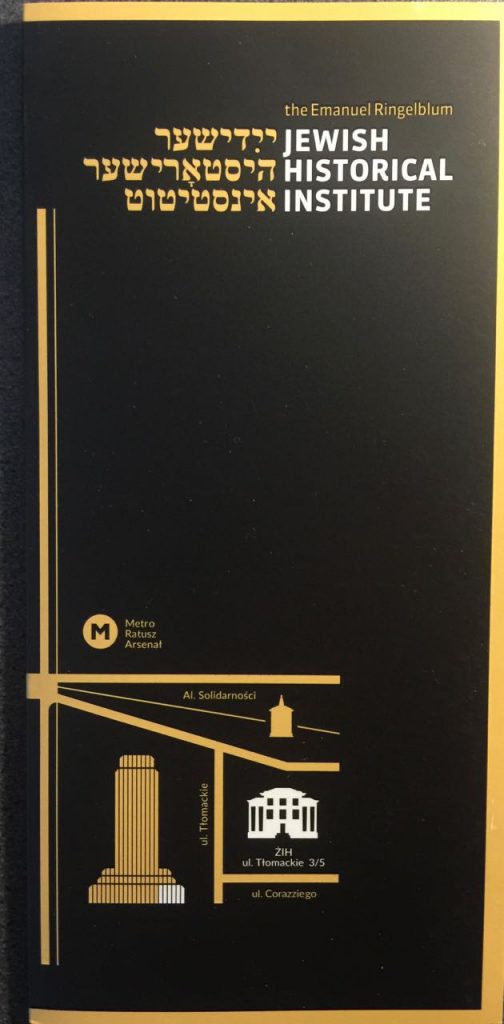
Jewish Historical Institute
From Wikipedia, the free encyclopedia
The Jewish Historical Institute (Polish: Żydowski Instytut Historyczny or ŻIH) is a research institute in Warsaw, Poland, primarily dealing with the history of Jews in Poland.
History
The Jewish Historical Institute was created in 1947 as a continuation of the Central Jewish Historical Commission, founded in 1944. The Jewish Historical Institute Association is the corporate body responsible for the building and the Institute’s holdings. The Institute falls under the jurisdiction of the Ministry of Culture and National Heritage. In 2009 it was named after Emanuel Ringelblum. The institute is a repository of documentary materials relating to the Jewish historical presence in Poland. It is also a centre for academic research, study and the dissemination of knowledge about the history and culture of Polish Jewry.
The most valuable part of the collection is the Warsaw Ghetto Archive, known as the Ringelblum Archive (collected by the Oyneg Shabbos). It contains about 6000 documents (about 30 000 individual pieces of paper).
Other important collections concerning World War II include testimonies (mainly of Jewish survivors of the Holocaust), memoirs and diaries, documentation of the Joint and Jewish Self-Help (welfare organizations active in Poland under the occupation), and documents from the Jewish Councils (Judenräte)
The section on the documentation of Jewish historical sites holds about 40 thousand photographs concerning Jewish life and culture in Poland.
The Institute has published a series of documents from the Ringelblum Archive, as well as numerous wartime memoirs and diaries.[1]
In 2011, Paweł Śpiewak, a Professor of Sociology at Warsaw University and former politician, was nominated as the Director of the Jewish Historical Institute by Bogdan Zdrojewski, Minister of Culture and National Heritage.[2]
The Nosyk Synagogue
Nożyk Synagogue
From Wikipedia, the free encyclopedia
| Nożyk Synagogue Synagoga Nożyków |
|
|---|---|
| Basic information | |
| Location | Warsaw, Poland |
| Geographic coordinates | 52°14′10″N 21°00′04″ECoordinates: 52°14′10″N 21°00′04″E |
| Affiliation | Orthodox Judaism |
| District | Śródmieście |
| Ecclesiastical or organizational status | Active Synagogue |
| Leadership | Rabbi Michael Schudrich |
| Website | http://www.warszawa.jewish.org.pl |
| Architectural description | |
| Architect(s) | Karol Kozłowski |
| Architectural style | neoromanesque |
| Completed | 1902 |
| Construction cost | 250.000 rubles |
| Specifications | |
| Capacity | 600 |
Interior of the synagogue
The Nożyk Synagogue (Polish: Synagoga Nożyków) is the only surviving prewar Jewish house of prayer in Warsaw, Poland. It was built in 1898-1902 and was restored after World War II. It is still operational and currently houses the Warsaw Jewish Commune, as well as other Jewish organizations.
History
Before World War II the Jewish community of Warsaw, one of the largest Jewish communities in the world at that time, had over 400 houses of prayer at its disposal. However, at the end of 19th century only two of them were separate structures, while the rest were smaller chapels attached to schools, hospitals or private homes. The earliest Round Synagogue in the borough of Praga served the local community since 1839, while the Great Synagogue (erected in 1878) was built for the reformed community. Soon afterwards a need arose to build a temple also for the orthodox Jewry. Between 1898 and 1902 Zalman Nożyk, a renowned Warsaw merchant, and his wife Ryfka financed such temple at Twarda street, next to the neighbourhood of Grzybów and Plac Grzybowski. The building was designed by a famous Warsaw architect, Karol Kozłowski, author of the Warsaw Philharmonic Orchestra Hall.[1] The façade is neo-romanticist, with notable neo-Byzantine elements. The building itself is rectangular, with the internal chamber divided into three aisles.
The synagogue was officially opened to the public on May 26, 1902. In 1914 the founders donated it to the Warsaw Jewish Commune, in exchange for yearly prayers in their intention. In 1923 the building was refurbished by Maurycy Grodzieński, who also designed a semi-circular choir that was attached to the eastern wall of the temple. In September 1939 the synagogue was damaged during an air raid. During World War II the area was part of the Small Ghetto and shared its fate during the Ghetto Uprising and then the liquidation of the Jewish community of Warsaw by the Nazis. After 1941 the Germans used the building as stables and a depot. After the war the demolished building was partially restored and returned to the Warsaw Jewish Commune, but the reconstruction did not start. It was completely rebuilt between 1977 and 1983 (officially opened April 18, 1983). It was also then that a new wing was added to the eastern wall, currently housing the seat of the commune, as well as several other Jewish organizations.
Ghetto Wall Marking
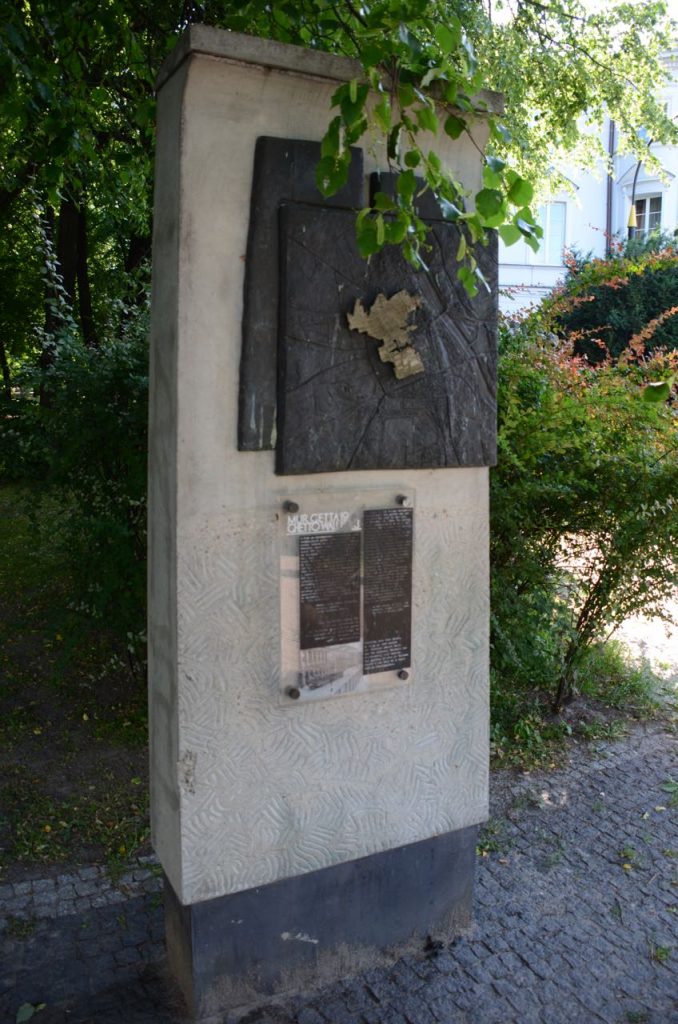

Meetings
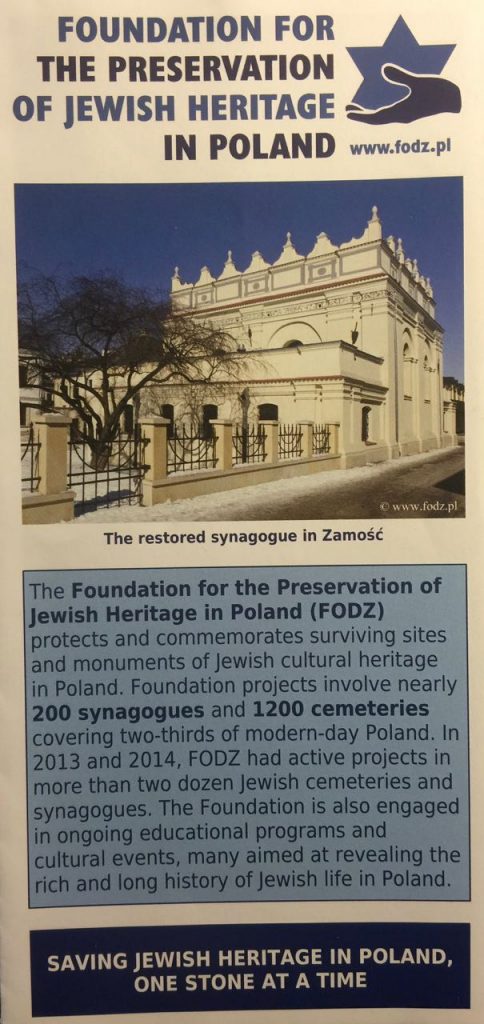
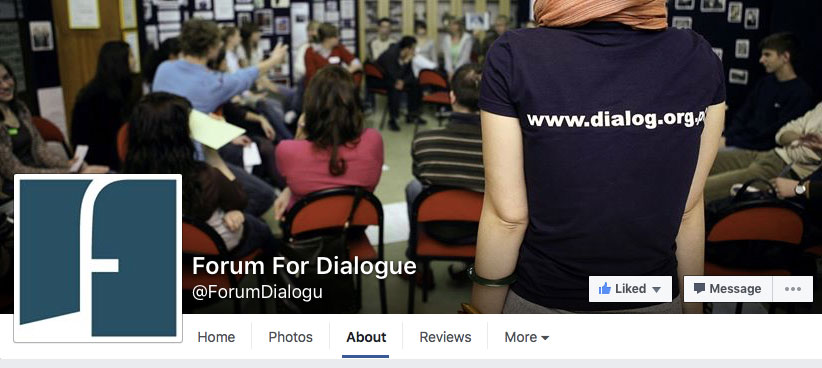
Chopin and Kopernicus
The Storm
<
►
>
The Tomb of the Unknown Soldier
Tomb of the Unknown Soldier
From Wikipedia, the free encyclopedia
The Tomb of the Unknown Soldier (Polish: Grób Nieznanego Żołnierza) is a monument in Warsaw, Poland, dedicated to the unknown soldiers who have given their lives for Poland. It is one of many such national tombs of unknowns that were erected after World War I, and the most important such monument in Poland.[1]
The monument, located at Piłsudski Square, is the only surviving part of the Saxon Palace that occupied the spot until World War II. Since 2 November 1925 the tomb houses an unidentified body of a young soldier who fell during the Defence of Lwów. At a later date earth from numerous battlefields where Polish soldiers have fought was added to the urns housed in the surviving pillars of the Saxon Palace.
The Tomb is constantly lit by an eternal flame and assisted by a guard post by the Representative Battalion of the Polish Army. It is there that most official military commemorations take place in Poland and where foreign representatives lay wreaths when visiting Poland.
The changing of the guard takes place on the hour of every hour daily and this happens 365 days a year.
History
In 1923, a group of unknown Varsovians placed, before Warsaw’s Saxon Palace and the adjacent Saxon Garden, a stone tablet commemorating all the unknown Polish soldiers who had fallen in World War I and the subsequent Polish-Soviet War. This initiative was taken up by several Warsaw newspapers and by General Władysław Sikorski. On April 4, 1925, the Polish Ministry of War selected a battlefield from which the ashes of an unknown soldier would be brought to Warsaw. Of some 40 battles, that for Lwów was chosen. In October 1925, at Lwów’s Cemetery of the Defenders of Lwów, three coffins were exhumed: those of an unknown sergeant, corporal and private. The coffin that was to be transported to Warsaw was chosen by Jadwiga Zarugiewiczowa, mother of a soldier who had fallen at Zadwórze and whose body had never been found.
On November 2, 1925, the coffin was brought to Warsaw’s St. John’s Cathedral, where a Mass was held. Afterward eight recipients of the order of Virtuti Militari bore the coffin to its final resting place beneath the colonnade joining the two wings of the Saxon Palace. The coffin was buried along with 14 urns containing soil from as many battlegrounds, a Virtuti Militari medal, and a memorial tablet. Since then, except under German occupation during World War II, an honor guard has continuously been held before the Tomb.
Architecture
The Tomb was designed by the famous Polish sculptor, Stanisław Kazimierz Ostrowski. It was located within the arcade that linked the two symmetric wings of the Saxon Palace, then the seat of the Polish Ministry of War. The central tablet was ringed by 5 eternal flames and 4 stone tablets bearing the names and dates of battles in which Polish soldiers had fought during World War I and the Polish–Soviet War (1919–21). Behind the Tomb were two steel gratings bearing emblems of Poland’s two highest Polish military decorations — the Virtuti Militari and Cross of Valor.
During the 1939 invasion of Poland, the building was slightly damaged by German aerial bombing, but it was quickly rebuilt and seized by the German authorities. After the Warsaw Uprising, in December 1944, the palace was completely demolished by the Wehrmacht. Only part of the central colonnade, sheltering the Tomb, was preserved.
After the war, in late 1945, reconstruction began. Only a small part of the palace, containing the Tomb, was restored by Henryk Grunwald. On 8 May 1946 it was opened to the public. Soil from 24 additional battlegrounds was added to the urns, as well as more tablets with names of battles in which Poles had fought in World War II. However, the communist authorities erased all trace of the Polish–Soviet War of 1920, and only a few of the Polish Armed Forces’ battles in the West were included. This was corrected in 1990, after Poland had regained its political autonomy.
There are plans to rebuild the Saxon Palace, but as of May 2016, these plans have been indefinitely on hold due to a lack of budget.[citation needed]
The Hotel Bristol
Hotel Bristol, Warsaw
From Wikipedia, the free encyclopedia
| Hotel Bristol, Warsaw | |
|---|---|

Hotel Bristol, Warsaw (2011)
|
|
| General information | |
| Location | Warsaw, Poland |
| Address | Krakowskie Przedmiescie 42/44 |
| Opening | November 19, 1901 |
| Owner | Towarzystwo Akcyjne Budowy i Prowadzenia Hotelów, (1901-1928), Bank Cukrownictwa (1928-1948), City of Warsaw (1947-1952), Orbis (1952-1977), University of Warsaw (1977-1981), Orbis (1981-2011), Rosmarinum Investments (2011-) |
| Management | Starwood Hotels |
| Design and construction | |
| Architect | Władysław Marconi |
| Other information | |
| Number of rooms | 168 |
| Number of suites | 38 |
| Website | |
| www.hotelbristolwarsaw.pl | |
Hotel Bristol, Warsaw is a historic luxury hotel opened in 1901 located on Krakowskie Przedmieście in Poland‘s capital, Warsaw
History
The Hotel Bristol was constructed from 1899-1900 on the site of the Tarnowski Palace by a company whose partners included Polish pianist Ignacy Jan Paderewski. A competition was held for the design of the building, and architects Thaddeus Stryjeriski and Franciszek Mączyński won with their Art Nouveau design. However the builders decided to change the style to a Neo-Renaissance design, and brought in architect Władysław Marconi to design the final hotel. Some of its interiors were designed by the noted Viennese architect Otto Wagner. The cornerstone was laid on April 22, 1899 and the hotel was dedicated on November 17, 1901 and opened on November 19, 1901.
Elegant cafe in the Bristol designed by Otto Wagner, 1901
After Poland gained its independence in 1919, Paderewski became the Prime Minister and held the first session of his government at his hotel. Paderewski and his partners sold their shares in the hotel in 1928 to a local bank, which renovated the hotel in 1934 with modern interiors by designer Antoni Jawornicki.
Upon the German invasion in 1939, the hotel was made into the headquarters of the Chief of the Warsaw District. It miraculously survived the war relatively unscathed, standing nearly alone among the rubble of its neighborhood. Following the war, the hotel was renovated and reopened in 1945.
The City of Warsaw took over operation of the hotel in 1947 and it was nationalized in 1948 and joined the state-run Orbis chain in 1952, exclusively serving visitors from abroad. By the 1970s its outdated facilities had seen it demoted to a second class ranking by the government and the hotel was donated by Prime Minister Peter Jaroszewicz to the University of Warsaw in 1977 to eventually serve as their library. It closed in 1981. However no work was done and the building languished through the waning days of the Communist government.
After the fall of Communism in 1989, the hotel was finally completely restored it to its former glory from 1991-1993, with the original interiors of the public rooms recreated to match the 1901 designs. The Bristol was reopened on April 17, 1993, with Margaret Thatcherin attendance, as part of the British Forte Hotels chain. From 1998 to 2013, the hotel was part of the Le Méridien hotel chain. The exterior was further restored in 2005, and the interior redecorated in 2013, after which the hotel joined The Luxury Collection division of Starwood Hotels.
Warsaw Uprising Youth Monument
Mały Powstaniec
From Wikipedia, the free encyclopedia
| Mały Powstaniec | |
 |
|
| Coordinates | 52°14′59″N 21°0′34″ECoordinates: 52°14′59″N 21°0′34″E |
|---|---|
| Location | Warsaw Old Town, Warsaw, Poland |
| Designer | Jerzy Jarnuszkiewicz |
| Material | Bronze sculpture |
| Completion date | 1 October 1983 |
| Dedicated to | The child soldiers of the Warsaw Uprising |
Mały Powstaniec (the “Little Insurgent”) is a statue in commemoration of the child soldiers who fought and died during the Warsaw Uprising of 1944. It is located on Podwale Street, next to the ramparts of Warsaw’s Old Town.
The statue is of a young boy wearing a helmet too large for his head and holding a submachine gun. It is reputed to be of a fighter who went by the pseudonym of “Antek”, and was killed on 8 August 1944 at the age of 13. The helmet and submachine gun are stylized after German equipment, which was captured during the uprising and used by the resistance fighters against the occupying forces.
Jerzy Jarnuszkiewicz[1] created the design for the monument in 1946, which was later used to make smaller copies of its present state. The statue was unveiled on October 1, 1983 by Professor Jerzy Świderski – a cardiologist who was a courier for the resistance during the uprising (pseudonym: “Lubicz”) serving in the Gustaw regiment of the Armia Krajowa. Behind the statue is a plaque with the engraved words of “Warszawskie Dzieci” (“Warsaw Children”), a popular song from the period: “Warszawskie dzieci, pójdziemy w bój – za każdy kamień twój, stolico damy krew” (“We’re the children of Warsaw, going into battle – for every stone of yours, we will give our blood”).
More Warsaw
Warsaw at night
Lublin, Poland

My thanks to Emil Majuk for showing me around and for being such an excellent guide!
The Chachmei Lublin Yeshiva Synagogue
<
►
>
Chachmei Lublin Yeshiva Synagogue
From Wikipedia, the free encyclopedia
| Synagogue in Chachmei Lublin Yeshiva Synagoga w Jeszywas Chachmej Lublin |
|
|---|---|
 |
|
| Basic information | |
| Location | Lublin, Poland |
| Affiliation | Orthodox Judaism |
| Status | active |
| Materials | brick |
The Synagogue in Chachmei Lublin Yeshiva is a synagogue located in Lublin, Poland, in the building of Chachmei Lublin Yeshiva, on Lubartowska 85 (originally 57) Street.
History
The synagogue was completed in 1930 along with the rest of the complex of the Chachmei Lublin Yeshiva. Apart from religious functions, it was used as a lecture hall for the yeshiva[1] [2] , having been able to seat over 200 students. During the Second World War, the building was vandalized by the Nazis, and all of the contents were damaged or dispersed.
After the war, the building of the yeshiva was taken over by the Medical University of Lublin. The room of the synagogue was redecorated and adjusted to needs of the University. The colouring of walls and columns was changed, and the windows located on the Eastern wall were bricked up.
In late 2003, the building was returned to the Jewish Community of Warsaw, which decided to redecorate and reconstruct the synagogue. The restoration commenced in May 2005, following the University’s departure from the structure. A rotten ceiling over the prayer room was replaced, and a new parquet floor was laid. Relying in part on pre-War photographs, the original colouring of columns and the windows on the Eastern wall were recreated. Also, the bimah and steps to Ark, which were surrounded by a balustrade, were restored.
However, the Ark could not be recreated at the time. In its place, a wardrobe and 2-metre (7 ft) high chandelier with 16 lights was installed. In the second half of 2007, the kehilla ordered the missing elements of the interior.
Renewed opening
Official opening of the synagogue took place on February 11, 2007. As the reconstruction of the interior of the synagogue was funded entirely by the Polish-Jewish Community, it was the first such ceremony in the post-War Poland.
During the ceremony, two replicas of mezuzahs with Polish Eagle were placed- the first one on the front door of Chachmei Lublin Yeshiva, and the other one on door of the synagogue. The original mezuzah had been donated during the opening in 1930 by a tzadik from Czortków(now Chortkiv, Ukraine), Israel Friedman. Next, the chief rabbi of Poland, Michael Schudrich carried in a Sefer Torah, funded on June 17, 2005 by Americans Harley and Marie Lippman, on the occasion of their daughter Juliet’s Bat Mitzvah. Originally the Torah was located in Nożyk Synagogue in Warsaw, but on January 22, 2006 it was carried into the Small Synagogue in Chachmei Lublin Yeshiva, after which it was returned to Warsaw. The Foundation for the Preservation of Jewish Heritage in Poland donated a gold-plated menorah and a plaque about the extermination of the Jews of Lublin.
There was over 600 guests for the ceremony, including representatives of Polish and foreign Jewish community as well people from university, cultural and religious fields: Michael Schudrich, Piotr Kadlčik, chairman of Lublin branch of the Jewish Community of Warsaw Roman Litman, Israel‘s ambassador to Poland David Peleg, metropolitan archbishop of Lublin Józef Życiński, president of Lublin Adam Wasilewski, representatives of local government, rabbi Yehiel Kaufman from Borough Park, Brooklyn, Jehuda Widawski, inhabitant of Lublin and other guests.[3] [4]
For more info, visit the Lublin KehilaLink
http://kehilalinks.jewishgen.org/lublin/Yeshiva_Synagogue.html
The Hotel Ilan
<
►
>
The Mikvah in the Hotel
<
►
>
The Old Jewish Cemetery
<
►
>
Old Jewish Cemetery, Lublin
From Wikipedia, the free encyclopedia

Graves at Old Jewish Cemetery, Lublin.
|
|
| Details | |
|---|---|
| Established | 1541 (probable) |
| Location | Lublin, Poland |
| Country | Poland |
| Coordinates | 51°15′08″N 22°34′45″ECoordinates: 51°15′08″N 22°34′45″E |
| Type | Jewish cemetery |
| Size | 1 ha |
The Old Jewish Cemetery (Polish: Stary Cmentarz Żydowski w Lublinie), in Lublin, Poland, is located on a hill between Kalinowszczyzna and Sienna Streets. The cemetery overlooks the Old Town and is entirely surrounded by a high, seventeenth-century wall. It is located on the site of a former medieval fortress, and was once surrounded by numerous backwaters.
The cemetery was probably founded in 1541, although some sources give a much earlier date. The first written mention of the cemetery dates from 1555, when a privilege was issued to Polish Jews permitting burial in the area.
Many distinguished representatives of the Lublin Jewish community are buried there. Many of them have monumental and richly decorated matzevot headstones, but there are also matzevot without ornaments, which are evidence of modesty. In 1939 the cemetery probably held up to 3,000 matzevot. After the German occupation of Poland in 1939 and the start of the Holocaust, many of the matzevot were demolished or were used for street paving. The matzevot of several significant figures, however, remain.
In the 1980s, the Association for the Preservation of the Jewish Heritage in Lublin (Towarzystwo Opieki nad Pamiątkami Kultury Żydowskiej) began to put the cemetery in order and to make a detailed inventory. Between 1988 and 1991 several antisemitic acts of vandalism took place, as a result of which 40 further matzevot (Macewy) were destroyed.
Currently, the Old Jewish Cemetery in Lublin provides some of the last surviving physical evidence of the centuries-old presence of Jews in the city.
Notable interments
Grodzka Gate
<
►
>
Grodzka Gate – NN Theatre
From Wikipedia, the free encyclopedia
| Ośrodek “Brama Grodzka – Teatr NN” | |
 |
|
| Predecessor | NN Theatre |
|---|---|
| Location | |
| Coordinates | 51°14′58″N 22°34′11″ECoordinates: 51°14′58″N 22°34′11″E |
| Fields | culture heritage, education |
|
Director
|
Tomasz Pietrasiewicz |
|
Vice director
|
Witold Dąbrowski |
| Website | teatrnn |
The “Grodzka Gate – NN Theatre” Centre (Polish: Ośrodek “Brama Grodzka — Teatr NN”) is a cultural institution based in Lublin. It is housed in the Grodzka Gate also known as the Jewish Gate that historically used to be a passage from the Christian to the Jewish part of the city. In its activities the Center focuses on issues of cultural heritage. Polish-Jewish past of Lublin is the corner stone of art and educational programmes carried out by the “Gate”.[1]
History and Theater activities of the Center
NN Theater was established in 1990 in Lublin Drama Group, accommodated at that time in the Grodzka Gate and adjoining buildings.[2] In 1998 the theater became a detached, independent organization and received its current name Ośrodek “Brama Grodzka — Teatr NN”.[1]
In its infancy theater staged the plays based on works of Kafka, Hrabal and other authors. As Tomasz Pietrasiewicz explains, literary adaptation of Herman Melville novel “Moby-Dick” played on the stage in June 1995 became a farewell to the certain period of producer’s theater life. When after a long break he returned to stage direction again, the spotlight shifted to the storytelling.[3]
The Center also organizes festivals, such as “Miasto Poezji” (English: “City of Poetry”) and “Śladami Singera” (English: “Following I. B. Singer’s Traces”).
Expositions in the “Grodzka Gate”
Building of the Center has hosted many expositions, though its structure, characterized by a range of narrow corridors, some dead-end ones, is far from being an idyllic place for a “typical” exhibition. Thus, their creators had to “fit” their exhibit items in the space available.
In 2010 with financial endorsement of the Ministry of Culture and National Heritage of the Republic of Poland an exposition “Lublin. Pamięć Miejsca” (English: “Lublin. Memory of the Place”) was launched and has been operating ever since. It included some objects from the previous display “Portrait of the Place” and was enriched by some multimedia materials. One of the halls opens to visitors’ eyes a “Wall of voices” – boxes with installed speaker system. Pressing on one of the buttons you can listen to the stories about old Lublin – its smells, tastes, and sounds.
Numerous pieces of Kaiserpanorama, accompanying visitors through the whole course of exhibition, offer to have a look at pictures of interwar Lublin. In addition, there is a room dedicated to the Holocaust victims with seventy coloured photos of Lublin ghetto, taken by a German soldier Max Kirnberger.[4] In 2012 new photos were added to the gallery. They had been found on the roof of the building on Rynek 4 during its renovation. There, under the leads, wrapped in papers and rags 2,700 photocopies were discovered. The owners of the house handed them over to the “Grodzka Gate” for a period of ten years. Author of the photos is still unknown.[5]
A separate room is devoted to the Righteous Among the Nations from Lublin region (people who had been rescuing Jews during the Holocaust). It is a place, where visitors can read their personal stories and listen to their reminiscences. Another eye-catching item of the exposition are models of the old part of the city in 1930s – one actual and one multimedia one with replicas of 840 buildings, such as town houses, shops, synagogues etc.[6]
Historical and educational activities of “The Grodzka Gate – NN Theater”
Jews who come here ask us: why do you do this? After all, you are not Jews, but Poles, and Jewish town is not your history.
Poles ask us: why do you do this? After all, you are Poles, and Jewish town is not our history. Maybe you are Jewish?
We patiently explain that it is our common, Polish-Jewish history. In order to remember the killed Jews, you don’t have to be a Jew as well.
There must be more such gates in the world we live. Not only Polish-Jewish ones.[7]
Former Synagogue Complex of The Maharshal – Shlomo Luria
<
►
>
Videos
Chevra Nosim Synagogue
Thanks to Pawel and Luba Matraszek for their hospitality.
<
►
>
Ghetto Memorial


Other views of Lublin
<
►
>
The Train to Warsaw
<
►
>
Limmud Oz in Melbourne
IN MELBOURNE
Monday, June 27 • 12:15 – 13:15
Protecting our heritage: a call for action
Eli’s entertaining and informative presentation takes us on a pictorial journey of his research activities and his numerous visits to Poland and the Baltics. This leads to a discussion of the demographic changes in the Australian Jewish community. Eli calls for a re-evaluation in the way Australians connect to our shtetls and educate about Jewish family and cultural history. Eli proposes some ideas on how to do this. It’s about the legacy we can leave!
Presenters
Eli Rabinowitz
Eli is involved in many Jewish community activities. He films, photographs, researches and lectures internationally on Jewish heritage and cultural history. He brought the memories of Muizenberg exhibition to Australia, manages 60 websites for JewishGen.org and arranges Litvak heritage tours.
High Flying back to the Shtetl
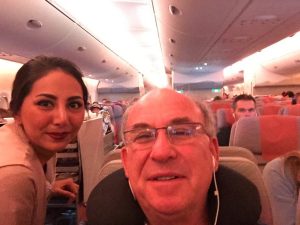
Somewhere over the Indian Ocean on my 6th visit to the shtetls of Europe.
This is my first live post from an aircraft at 12000 metres, thanks to the $1 wifi service Emirates offers on their A380 Airbus .
Posting from my iPhone 6+

Lots of entertainment on the 11 hour flight to Dubai, connecting with an 8 hour Qantas flight to London.

On Monday, I start my nine day drive around Lithuania. Lots of towns and shtetls to visit! I will be using Airbnb for the first time.
The following week I am in Kiev and Lviv, my first visit to the Ukraine.
On the final leg, I will be visiting Lublin and Warsaw in Poland before returning to Perth on 18 June.
I look forward to your company and feel free to comment. Let me know if am anywhere near your shtetl.
Global Shtetlnet Project – An Update
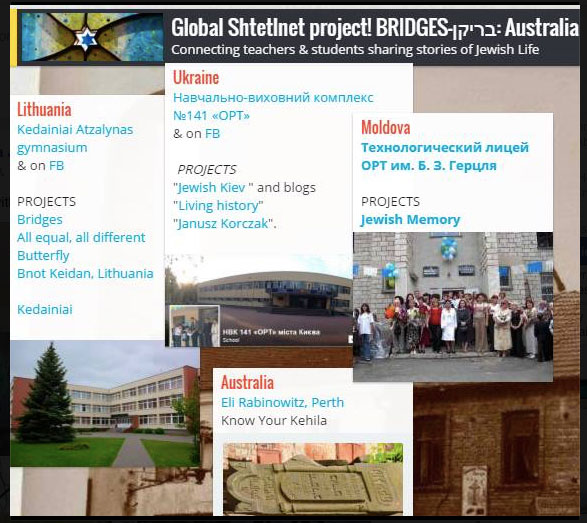
Our goal is to connect teachers and students at:
- Jewish Day Schools
- Tolerance Education Centre Schools (TEC) in Lithuania
- ORT schools in the FSU
- other similar educational institutions in the Baltics, Central and Eastern Europe
How:
- by sharing stories of Jewish life both past and present
- focus on the shtetl and kehilla
- exchange of ideas and projects
- small peer groups of students
- extending to a wider group
- no extra resources required by schools
Our list of participating schools:
Australia:
Moriah College, Sydney
Lithuania:
Atzalynas High School in Kedainiai
Kalvarijos High School in Kalvarija
Solomo Aleichemo ORT School in Vilnius
Moldova:
Technological Lycee ORT. BZ Herzl, Kishinev
South Africa:
United Herzlia Schools
King David Victory Park
Ukraine:
NVK #141 ORT Kiev
Technical assistance is provided by Steve Sherman of Living Maths in Cape Town: http://www.livingmaths.com
If you would like to join our group and for further information, contact
Eli Rabinowitz
Some videos from the students:
Two animated videos on the topic of the Holocaust, made by ORT high school students in Kiev.
Every year they discuss this topic using creative works of the students.
The film “Butterflies do not live in ghetto” based on the poem, written in 1942 by one of the Shoah’s victims – Paul Friedman.
The film “The dream about the theatre” is the project work in the preparation for the trip “Masa Shorashim” in Poland this year.
Journey To The Roots 2015 Маса Шорашим 2015
A video of the Kishinev ORT school students Masa Shorashim visit to Lithuania and Poland in 2015.
http://youtube.com/watch?v=pLXdbW8fUQc
Return To Nasielsk

Photo courtesy of Virtual Shtetl Portal – Wirtualny Sztetl
From: Glenn Kurtz
Dear Friends of Nasielsk!
I am very pleased to announce that the restoration and rededication of Nasielsk’s Jewish cemetery will take place this summer, from 3 – 8 July 2016.
You are invited to participate! Volunteers are welcome for all or any part of the project: a day, a few days, or the entire week.
As those of you who have visited Nasielsk know, the former Jewish cemetery is now a mature forest, overgrown and unkempt. Since no (or very few) headstones remain, our work this summer will be to clear the brush and the forest floor. We expect it will be a multi-year project. Once we have cleared the ground, we can discuss and decide on a memorial and a preservation plan.
We are fortunate and grateful to be partnering with the Foundation for the Preservation of Jewish Heritage in Poland (FODŻ), based in Warsaw, and the Matzevah Foundation, based in Atlanta. FODŻ, which has helped restore cemeteries and synagogues throughout Poland, will manage the legal and community relations aspects of the project, while the Matzevah Foundation will help with logistics and labor.
Each participant will be responsible for independent transportation to Warsaw. The Matzevah Foundation will collect a $300 fee to defray administrative and material expenses. Details regarding lodging, local transportation, etc., will be forthcoming in late April.
Our project has the support of Mayor Ruszkowski of Nasielsk and of the local community. We anticipate that high school students and other local volunteers will join us to assist with the clean up. Under the auspices of the cemetery project, we will have the opportunity to share the importance of Jewish history with local community members. As always, we hope our presence will encourage the local community to preserve the memory of Nasielsk’s Jewish history and to incorporate it into the school curriculum.
Finally, during our stay we may be privileged to participate in a ceremony honoring Helena Jagodzińska, sponsored by Yad Vashem and held at the new POLIN Museum of the History of Polish Jews in Warsaw. Helena helped Nasielsker Maurice Chandler to survive the war and was named a Righteous Gentile in January 2016. Her family (who accompanied us to the Polin Museum in October 2014) will receive the official commendation.
Please contact me or Michael Valihora with any questions or if you would like to participate.
We hope you will join us!
Glenn
Visit the Nasielsk KehilaLink
My Talk At Claremont Wynberg Shul, Cape Town






















































































































































































































































































































































































































































